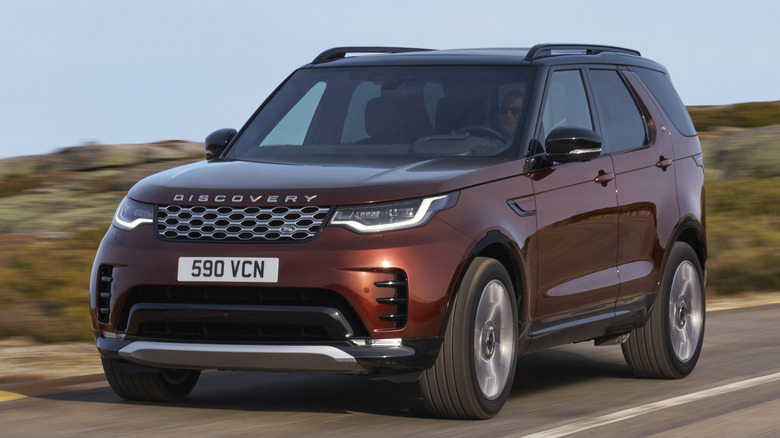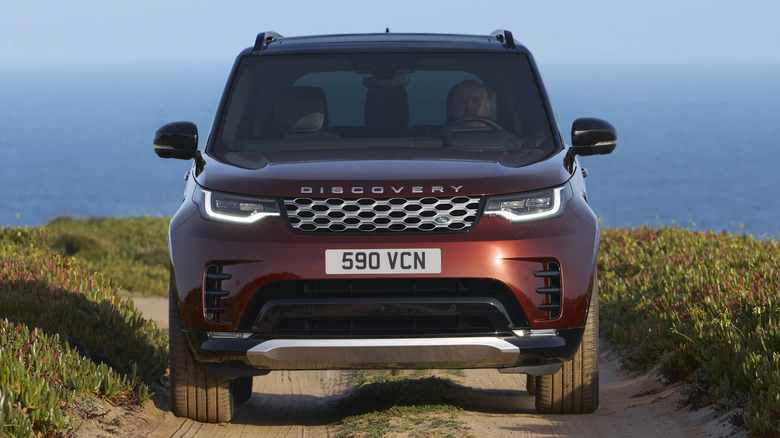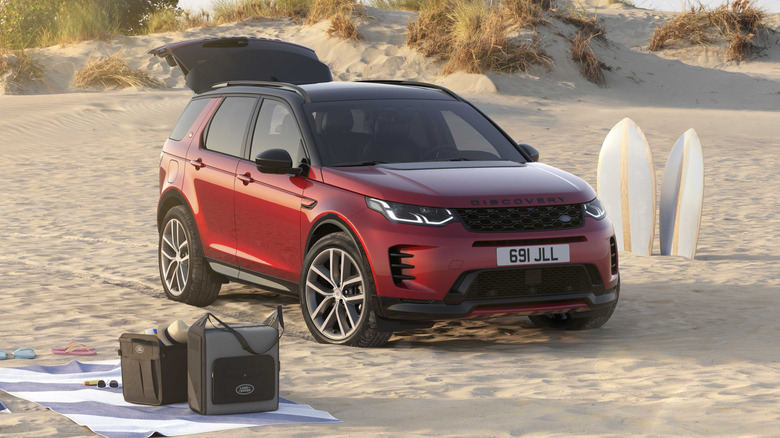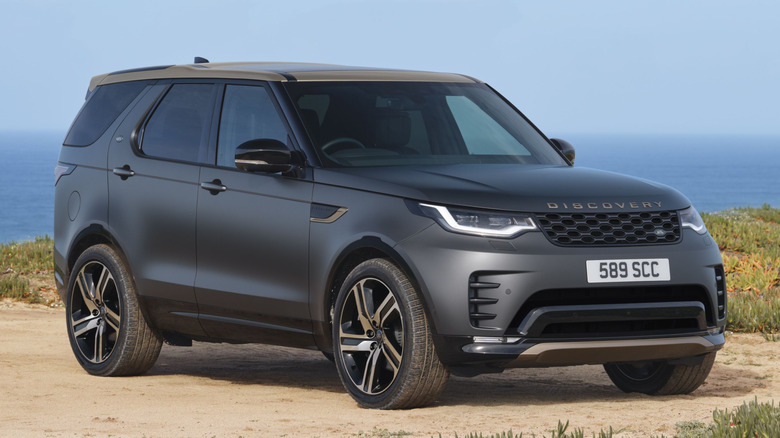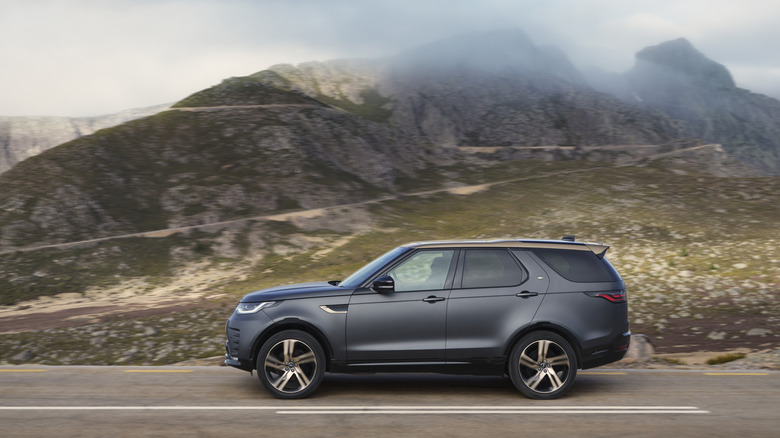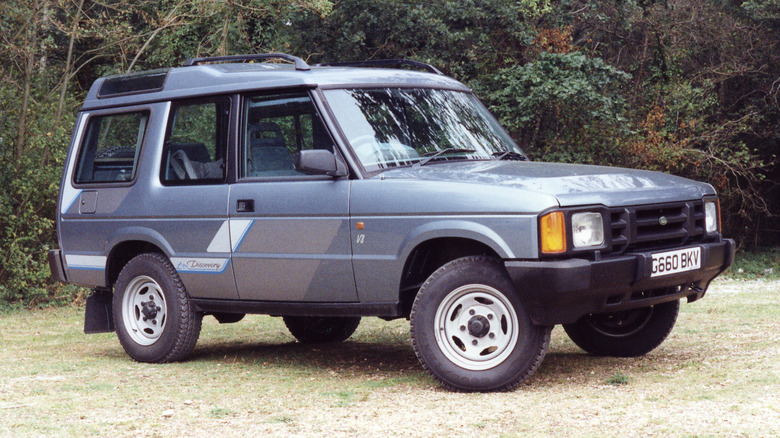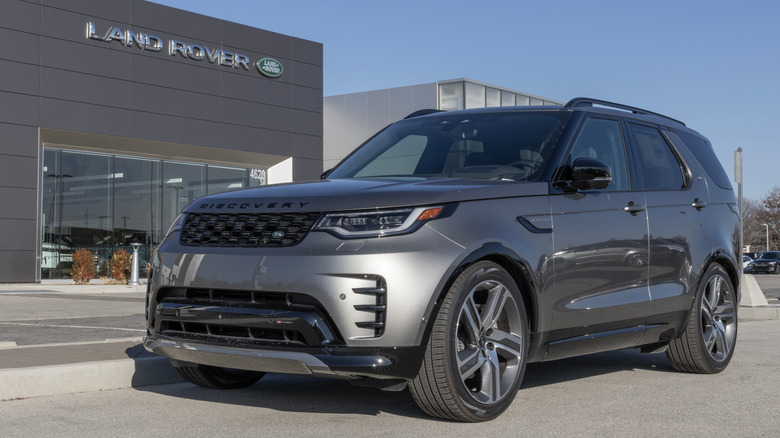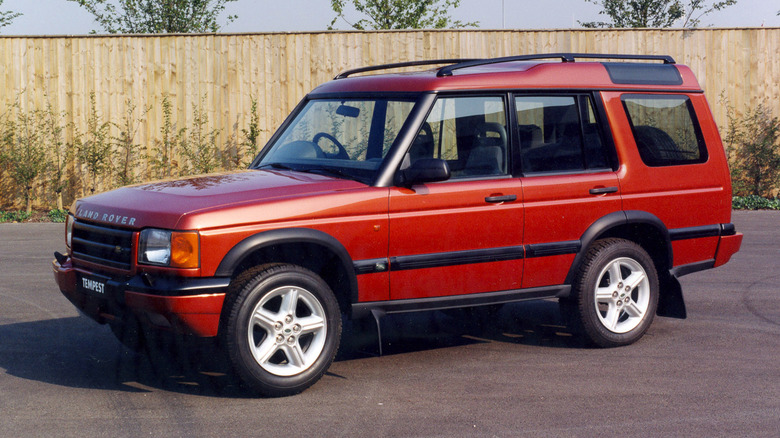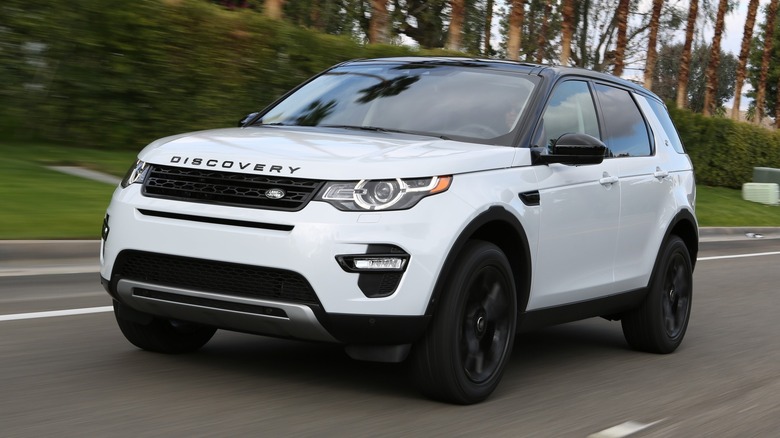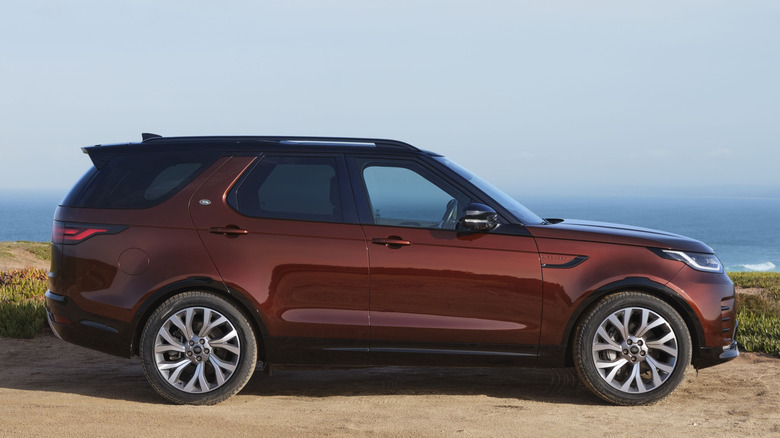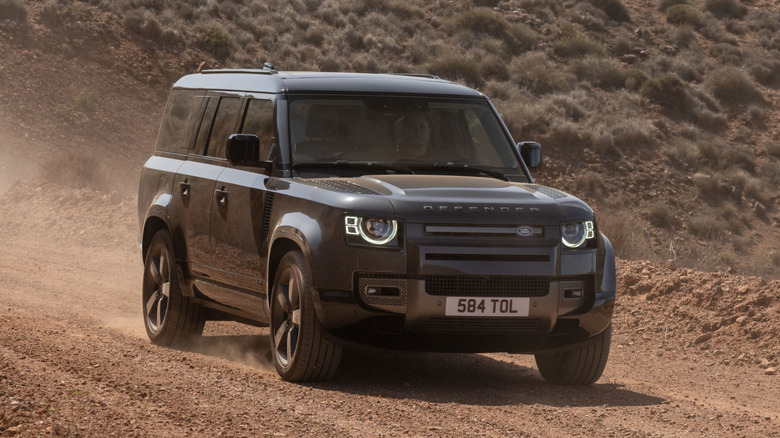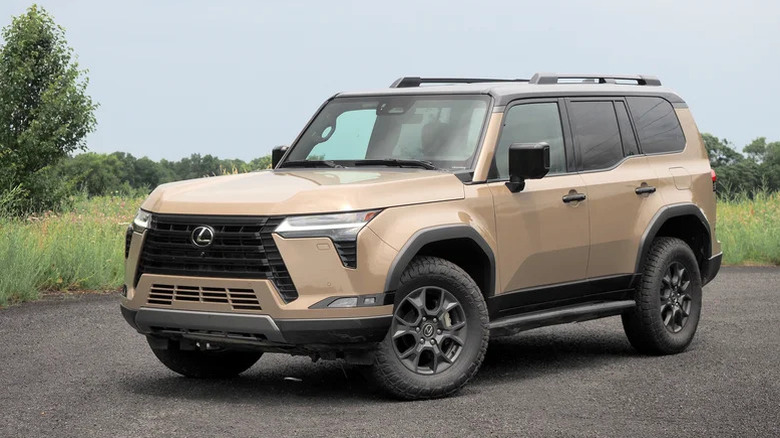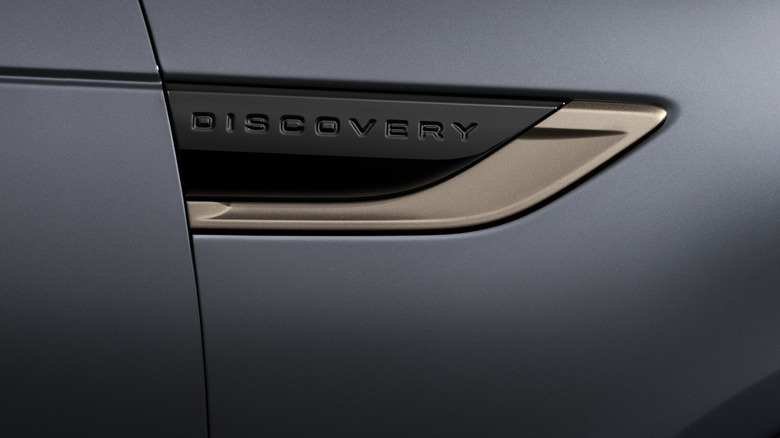13 Things You Should Know Before Buying A Land Rover Discovery (New Or Used)
Buyers on the hunt for an upmarket three-row SUV aren't short on options, and that's partly why the Land Rover Discovery isn't a commercial hit in the same way as its Land Rover stablemates. Both the Defender and Range Rover models have seen very strong demand from buyers despite uncertainty around tariffs, but the Discovery has not seen the same surge in sales. Nonetheless, there's plenty to like about the Discovery and its sister model, the smaller Discovery Sport, no matter whether you're buying a new or used example.
The Discovery's emphasis on family-friendly hauling capabilities sets it apart from other models in the Land Rover range, but like any good Land Rover, it's still impressively capable off-road. It's now one of the brand's older models, but age hasn't diminished its appeal. However, given that it faces such tough competition both from within Land Rover's own lineup and from rival manufacturers, it's worth making sure you're in the loop about the Discovery's charms and drawbacks before you head to a dealership. Whether you're looking for a new Disco or an older example, we think these 13 things are worth knowing before you buy.
1. The Discovery starts from $62,050 for 2026
The cheapest Discovery trim for the 2026 model year is the Discovery S, which starts from $62,050 (including a $1,850 destination and delivery fee). This base trim packs a 2.0L four-cylinder engine with 296 horsepower on offer, giving the Discovery an officially quoted 0-60 mph time of 6.9 seconds. The next step up in the range is the Discovery Dynamic SE, which starts from $66,450. It adds features like an 18-way power adjustable driver's seat, an upgraded audio system, and a powered tailgate.
Two special edition versions of the Discovery have also been launched for 2026, which are discussed below. The cheaper of those is the Discovery Gemini, which starts from $72,650, while the range-topping variant is the Discovery Tempest, which will cost at least $85,350. Both top trims feature a 3.0L six-cylinder engine producing 355 horsepower, enough to push the car from 0-60 mph in 6.2 seconds. Land Rover also offers a sizable packages and options list which can tip the car's final price north of $90,000. That puts it around the same price as an entry-level Range Rover Sport.
2. The smaller Discovery Sport starts from $51,175 for 2026
The sister model to the full-size Discovery is the Discovery Sport, which starts from $51,175 (including a delivery and destination fee of $1,275) for the latest model year. It's only available in a single trim, the Discovery Sport Landmark, and features a 2.0L four-cylinder engine that produces 249 horsepower. It's available either in five-seat configuration or as a seven-seater, although the rearmost seats are small — Land Rover refers to the layout as a 5+2 seater.
Much like the full-size Discovery, the only no-cost paint option available for the Discovery Sport is Fuji White. However, unlike its larger sibling, the Discovery Sport can be optionally finished in metallic red and a shade of dark blue that Land Rover calls Varesine Blue, as well as a range of other grayscale colors. Both the red and the blue metallic finishes are a $950 option, while white and gray "premium metallic" finishes are available and add $1,550 to the final bill.
3. The 2026 model year will see the launch of multiple special editions
Both the Discovery and Discovery Sport are available in new special edition configurations for the 2026 model year. As of this writing, the only trim available for the Discovery Sport is the Landmark special edition, which includes a panoramic roof, a surround-view camera, and dual-zone climate control. It also receives some unique exterior trim and Landmark edition puddle lamps.
The Discovery gets two new special editions for 2026, the Gemini and Tempest editions. The Gemini edition adds the expected special edition trim alongside an integrated cooler compartment, quad-zone climate control, and a power tailgate that can be opened via gestures. As mentioned above, it also offers a more powerful engine than lower trims, with a six-cylinder engine replacing the base four-cylinder unit.
The Tempest is a pricey addition to the Discovery range, but it comes with plenty of upgrades to justify the added cost. Land Rover claims that it's "the most luxurious, comfortable and highly‑specified Discovery vehicle ever produced." As well as plush leather upholstery, the interior also features aluminum accents and unique detailing. In addition, it receives a distinctive copper-colored roof and matching exterior accents.
4. The mild hybrid Discovery is less efficient than its non-hybrid counterparts
It's often the case that powertrain electrification boosts fuel efficiency, but that's not the case with the Discovery. At least, not compared to the model's non-hybrid trims. Top-spec Discovery trims get a 3.0L six-cylinder MHEV (or mild hybrid electric vehicle) powertrain which achieves 19 mpg combined according to the EPA. In the city, it's only expected to hit 17 mpg, while on the highway, it should reach 23 mpg.
The base-spec four-cylinder engine in the Discovery is actually more fuel efficient than the larger hybrid powertrain, although only slightly. Per the EPA, it should achieve 21 mpg combined, with 19 mpg achievable in the city and 24 mpg on the highway. It also gives the Discovery a longer forecasted range between refueling stops — 500 miles compared to the MHEV's 452 miles.
The Discovery Sport's 2.0L four-cylinder engine sits in between the two Discovery powertrains in terms of fuel efficiency. It's officially rated for 20 mpg combined, and will hit a forecasted 19 mpg in the city and 23 mpg on the highway.
5. The Discovery was first launched in 1989
From its inception, the Discovery was designed to be a versatile family hauler that was less luxurious — and thus more affordable — than a Range Rover, but more refined on the road than a Defender. The first generation of the Discovery launched in 1989, and it remained on sale for a decade until the Discovery II hit dealerships in 1999.
The third generation Discovery arrived in time for the 2005 model year in America, but it lost the Discovery name. Instead, it was marketed in the U.S. as the LR3 or Land Rover 3. It was all-new both in its design and its construction, and featured a 4.4L V8 engine under its hood. The marque kept its new naming conventions with the launch of the LR4 in 2010, which lost its V8 engine but offered improved fuel efficiency as well as further on-road refinements. The LR4 remained on sale until 2017, when it was replaced by the fifth, current generation Discovery.
6. The current generation Discovery was launched in 2017
Land Rover wisely decided that the LR naming system was getting a bit confusing, and brought back the original Discovery nameplate for the latest generation of the SUV. We tested the Discovery at launch in 2017 and found it to be just as capable off-road as its predecessors, having put it through its paces on the trails of Utah and Arizona. It proved a capable companion both on the trails and on the highway, with its optional 3.0L turbodiesel engine offering an economical alternative for buyers not sold on the standard gas-powered 3.0L six-cylinder engine.
That diesel option has since been discontinued, although used examples can still readily be found for attractive prices. Used examples of the fifth generation Discovery still look more modern than some of their similarly aged rivals, too, since the model has seen no major styling changes since its debut for the 2017 model year.
7. The Discovery depreciates quickly
Buyers looking for even a lightly used Discovery won't need as large a budget as those shopping for a new example, as the model loses its value quickly once it leaves the dealership. According to estimates by KBB, the Discovery should retain only 35.9% of its sticker price after its first five years on the road. It sees the largest drop in value during its first year, with its depreciation tailing off considerably after that point. A two-year old Discovery is worth only little over half of its price when new, but there won't be as big of a difference in price between a four year old and five year old example.
The Discovery Sport drops similarly quickly in value, despite being cheaper to buy than its larger sibling. According to KBB, buyers can expect a new Discovery Sport to retain 36.3% of its value over half a decade. It follows a similar depreciation pattern to the Discovery, shedding almost half of its value in its first two years on the road and then depreciating more slowly from that point onwards.
8. Older examples of the Discovery are cheap to buy
Unlike the Defender, which remains a sought-after collectors' item, classic examples of the Discovery don't command a high price tag. The cheapest examples of the first generation Discovery can be found for $10,000 or less, with even clean, low mileage examples only rarely exceeding $25,000. The second generation Discovery is similarly affordable, with the cheapest examples of the second-generation car also able to be found for under $10,000.
The LR3 lacks the old-school styling of its predecessors, but it's also just as cheap, with average resale values sitting south of $10,000. The LR4 is more expensive on average, but still remains firmly in affordable territory. In used form, the Discovery is undeservedly overlooked: buyers will pay far less than they would for a Defender, but they'll have a car with similarly impressive off-road capability and the ability to transport a family and their luggage in comfort.
9. Reliability varies between model years
One of the big reasons that well-depreciated examples of the Discovery aren't selling like hotcakes despite their talents is that all aging Land Rovers carry a reputation for unreliability. Unfortunately, there's a good reason that Land Rovers carry that reputation, although it's not straightforward to predict exactly how unreliable any given generation or model year of the Discovery will be.
According to Consumer Reports, both the Discovery and Discovery Sport are predicted to be less reliable than the average new SUV, with that prediction based on the brand's overall reliability history. The outlet also ranks Land Rover as the costliest major brand for maintenance and repairs over time, even above Porsche. NHTSA data also highlights a few problem years, with the 2003 model year Discovery racking up the largest number of complaints to date and the 2015 Discovery Sport having the most recalls of any Discovery variant.
Most Discovery buyers will already be well aware of the brand's patchy reputation, but to give yourself the best chance of buying a reliable used car, it's worth checking owners' forums for the known weak spots of the particular generation or model year of Discovery that you're considering. Forums will have a wealth of information about the specific red flags to look for, but it's also being aware of the most common things to look out for when buying a used car, too.
10. The Discovery is built in Slovakia, not in the U.K.
Land Rover might be a famously British brand, but the Discovery hasn't been built in the U.K. since 2019. It's instead built at JLR's plant in Slovakia, which also handles the production of the Defender. The Slovakian plant is a relatively new addition to JLR's array of facilities, having only opened in 2018. It can reportedly build up to 150,000 cars per year. The Slovakian plant is designed to be significantly more efficient than the previous U.K. plant, but there are some downsides that come with making the car in the EU country.
The current U.S. government administration has launched tariffs on cars made outside America, although the U.K. has cut a deal to reduce the tariff to 10% as of this writing. The Range Rover model line, which is made in the U.K., will be subject to these reduced tariffs, but since the Discovery and Defender are made in the EU, they remain subject to hefty tariffs for now. The tariff situation is rapidly changing and a more favorable deal may be struck with the EU in future, but for now, Land Rover has not explicitly ruled out future price rises of its EU-built models, including the Discovery, for American buyers.
11. For all-terrain capability, the Defender is superior
Both the Discovery and its Slovakian-built stablemate, the Defender, are capable off-road. However, for pure all-terrain talent, it's the Defender that still has the edge. Buyers with suitably large budgets might want to consider the pricey Defender 130, which offers three rows of seats, much like the Discovery. Not only is it more capable, it's also more distinctive looking, with Land Rover's retro-modern interpretation of the iconic nameplate proving very popular with buyers.
The Defender 130 offers generous room for people and cargo, paired with the same mild-hybrid 3.0L six-cylinder engine that can also be found in the top-spec Discovery. However, it sports a price reflective of its capabilities and style, with a starting price of $71,550 (including a $1,850 destination and delivery fee) and a range of plusher trims that stretch into six-figure territory. The mid-range Defender 130 X-Dynamic SE trim costs $83,250, around the same as a top-spec Discovery Tempest.
12. The Discovery's segment is a crowded one
Even leaving aside the Discovery's in-house rivals, the range of alternative three-row SUVs available from other manufacturers is very broad. For luxury and family-hauling capability, the three-row Volvo XC90 is a great alternative to a top-spec Discovery, and it's received a facelift for the 2025 model year, too. It's also available as a plug-in hybrid, and is significantly more efficient than the Discovery.
For similar off-road capability and luxury, the recently overhauled Lexus GX is another strong contender. The Discovery isn't particularly fun to drive for its segment, but three-row SUVs don't have to be dull. The Acura MDX Type S proves it, being surprisingly engaging on backroads given its significant size.
The smaller, cheaper Discovery Sport also has plenty of rivals, like the impressive Genesis GV70, which has been upgraded for 2026. Similarly sized SUVs from leading German manufacturers like Mercedes-Benz, Audi, and BMW also provide strong competition. Buyers who laugh in the face of reliability charts might also want to consider the Alfa Romeo Stelvio, which arguably remains one of the best looking SUVs in its segment despite being far from perfect in other areas. None of these rivals offer the same all-terrain capability as a Discovery Sport, but it's safe to assume that the vast majority of buyers won't ever need that capability anyway.
13. The next Discovery might look very different to the current car
For now, the Discovery soldiers on in Land Rover's lineup mostly unchanged from previous years, although the launch of a sudden crop of special editions might be a hint that the current generation of the SUV is nearing the end of its life. JLR acknowledged that the direction of the next generation Discovery was under discussion as far back as 2023, although as of this writing, the brand has not officially announced when it plans to launch the next generation model.
Rumors suggest that the upcoming Discovery might look quite different to the current generation car, with JLR wanting to differentiate it better from the highly popular Defender line. It's also likely to have more electrified options than the current generation, potentially with an all-electric variant being offered. These rumors all remain unconfirmed for now though, and JLR already has plenty of big launches coming soon in the form of the long-awaited electric Range Rover and the endlessly controversial Jaguar rebrand. As a result, it might still be a little while until the Discovery receives an overhaul, even if its sales continue to be dwarfed by its more popular Defender sibling.
